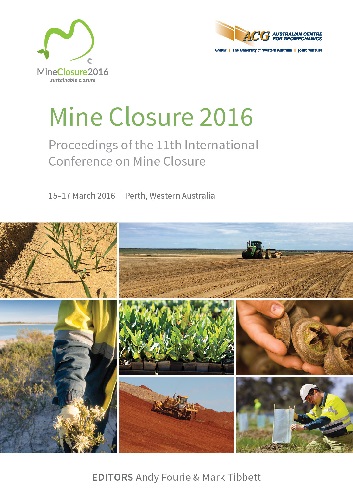Integrating the use of natural analogues and erosion modelling in landform design for closure

|
Authors: Kelder, I; Waygood, CG; Willis, T |
DOI https://doi.org/10.36487/ACG_rep/1608_04_Kelder
Cite As:
Kelder, I, Waygood, CG & Willis, T 2016, 'Integrating the use of natural analogues and erosion modelling in landform design for closure', in AB Fourie & M Tibbett (eds), Mine Closure 2016: Proceedings of the 11th International Conference on Mine Closure, Australian Centre for Geomechanics, Perth, pp. 99-106, https://doi.org/10.36487/ACG_rep/1608_04_Kelder
Abstract:
Landform design methodologies as applied in Australia use primarily one of three methods: Linear and empirical designs that consider primarily materials movement, Landform Evolution Models (such as WEPP or SIBERIA) to assess long-term erodibility of specific material within landforms, and hydrological models that use stable alluvial natural analogues in the local environment as a template for a stable unconsolidated landform shaped by water (typically Geofluv™ or similar). This paper is a case study on the use of elements of all three of these methods on Mangoola Open Cut, a large open cut coal mine in New South Wales, Australia, with a primary focus on the outcomes of an erosion modelling assessment of a Geofluv™ designed landform adapted to meet the site specific requirements. Construction of the landform commenced in 2012, and the performance to date has been encouraging, based on the short-term, prior to the establishment of vegetation. Short-term SIBERIA modelling was undertaken to inform the management of erosion risks in the short and long term, and in turn, facilitate ongoing flexibility for the construction of the landform. The modelling will also guide some aspects of revegetation. The modelling predicts that the average overall erosion rate in the long term (500 years) will be similar to the erosion rates of natural landforms in the general area.
Keywords: case study, landform design, erosion modelling, natural analogues, non-linear methodologies, Geofluv®, SIBERIA
References:
Bugosh, N 2003, Stream channel design reclamation – The fluvial geomorphic approach to hydrological reclamation, Annual Meeting of the American Society of Mining and Reclamation, Billings, Montana.
Darwin Harbour Advisory Committee 2010, Sediment, nutrients, organic matter and metal inputs to Darwin Harbour from its catchment, and the ecological impacts on the Harbour, Ecosystem Research Group.
Elliot, GL & Dight, DCG 1986, An evaluation of the surface stability of rehabilitated overburden in the upper Hunter Valley, NSW, report to NSW Coal Association, Sydney.
Flanagan, DC & Nearing, MA 1995, USDA – Water erosion prediction project, Hillslope profile and watershed model documentation, NSERL Report No. 10, USDA-ARS National Soil Erosion Research Laboratory, West Lafayette, Indiana.
Hancock, G, Loughran, R, Evans, K & Balog, R 2008, ‘Estimation of soil erosion using field and modelling approaches in an undisturbed Arnhem Land catchment, Northern Territory, Australia’, Geographical Research, 46(3), pp. 333–349.
Hancock, GR, Lowry, JBC, Coulthard, TJ, Evans, KG & Moliere, DR 2010, ‘A catchment scale evaluation of the SIBERIA and CAESAR landscape evolution models’, Earth Surface Processes and Landforms, vol. 35, issue 8, pp. 863–875.
Landloch 2011, RE: Development of recommendations for the Mangoola waste landform, Letter report to Mr Ben Clibborn – Environmental & Community Manager.
Willgoose, G & Riley, S 1998, ‘The long-term stability of engineered landforms of the Ranger Uranium Mine, Northern Territory, Australia: application of a catchment evolution model’, Earth Surface Processes and Landforms, vol. 23, pp. 237–259.
Willgoose, GR, Bras, RL & Rodriguez-Iturbe, I 1989, ‘Modelling of the erosional impacts of land use change: A new approach using a physically based catchment evolution model’, in Hydrology and Water Resources Symposium 1989, The Institute of Engineers Australia, Melbourne, pp. 325–329.
© Copyright 2026, Australian Centre for Geomechanics (ACG), The University of Western Australia. All rights reserved.
View copyright/legal information
Please direct any queries or error reports to repository-acg@uwa.edu.au
View copyright/legal information
Please direct any queries or error reports to repository-acg@uwa.edu.au